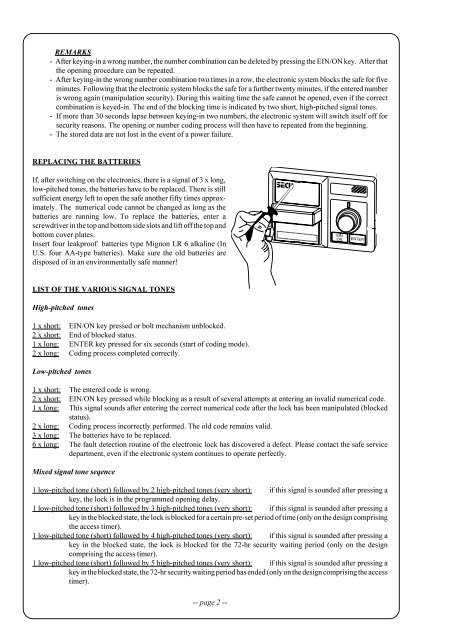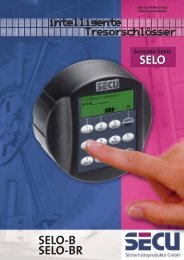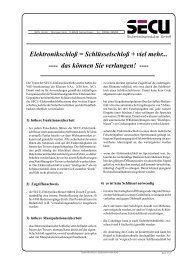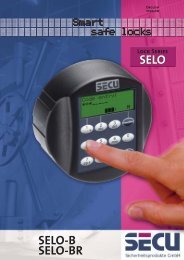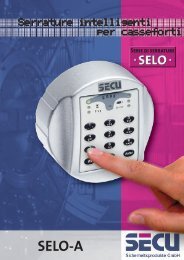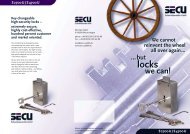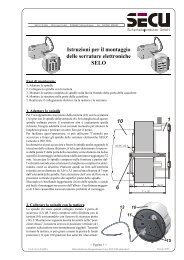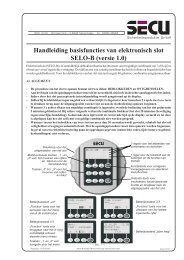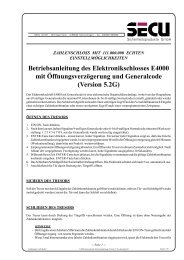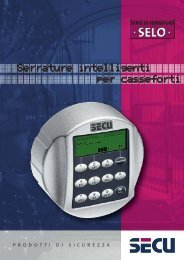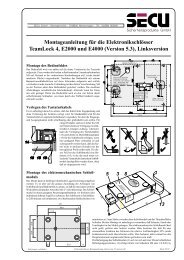Operating Instructions for Electronic Lock E6000R with Opening ...
Operating Instructions for Electronic Lock E6000R with Opening ...
Operating Instructions for Electronic Lock E6000R with Opening ...
You also want an ePaper? Increase the reach of your titles
YUMPU automatically turns print PDFs into web optimized ePapers that Google loves.
REMARKS<br />
- After keying-in a wrong number, the number combination can be deleted by pressing the EIN/ON key. After that<br />
the opening procedure can be repeated.<br />
- After keying-in the wrong number combination two times in a row, the electronic system blocks the safe <strong>for</strong> five<br />
minutes. Following that the electronic system blocks the safe <strong>for</strong> a further twenty minutes, if the entered number<br />
is wrong again (manipulation security). During this waiting time the safe cannot be opened, even if the correct<br />
combination is keyed-in. The end of the blocking time is indicated by two short, high-pitched signal tones.<br />
- If more than 30 seconds lapse between keying-in two numbers, the electronic system will switch itself off <strong>for</strong><br />
security reasons. The opening or number coding process will then have to repeated from the beginning.<br />
- The stored data are not lost in the event of a power failure.<br />
REPLACING THE BATTERIES<br />
If, after switching on the electronics, there is a signal of 3 x long,<br />
low-pitched tones, the batteries have to be replaced. There is still<br />
sufficient energy left to open the safe another fifty times approximately.<br />
The numerical code cannot be changed as long as the<br />
batteries are running low. To replace the batteries, enter a<br />
screwdriver in the top and bottom side slots and lift off the top and<br />
bottom cover plates.<br />
Insert four leakproof batteries type Mignon LR 6 alkaline (In<br />
U.S. four AA-type batteries). Make sure the old batteries are<br />
disposed of in an environmentally safe manner!<br />
LIST OF THE VARIOUS SIGNAL TONES<br />
High-pitched tones<br />
1 x short: EIN/ON key pressed or bolt mechanism unblocked.<br />
2 x short: End of blocked status.<br />
1 x long: ENTER key pressed <strong>for</strong> six seconds (start of coding mode).<br />
2 x long: Coding process completed correctly.<br />
Low-pitched tones<br />
1 x short: The entered code is wrong.<br />
2 x short: EIN/ON key pressed while blocking as a result of several attempts at entering an invalid numerical code.<br />
1 x long: This signal sounds after entering the correct numerical code after the lock has been manipulated (blocked<br />
status).<br />
2 x long: Coding process incorrectly per<strong>for</strong>med. The old code remains valid.<br />
3 x long: The batteries have to be replaced.<br />
6 x long: The fault detection routine of the electronic lock has discovered a defect. Please contact the safe service<br />
department, even if the electronic system continues to operate perfectly.<br />
Mixed signal tone seqence<br />
1 low-pitched tone (short) followed by 2 high-pitched tones (very short): if this signal is sounded after pressing a<br />
key, the lock is in the programmed opening delay.<br />
1 low-pitched tone (short) followed by 3 high-pitched tones (very short): if this signal is sounded after pressing a<br />
key in the blocked state, the lock is blocked <strong>for</strong> a certain pre-set period of time (only on the design comprising<br />
the access timer).<br />
1 low-pitched tone (short) followed by 4 high-pitched tones (very short): if this signal is sounded after pressing a<br />
key in the blocked state, the lock is blocked <strong>for</strong> the 72-hr security waiting period (only on the design<br />
comprising the access timer).<br />
1 low-pitched tone (short) followed by 5 high-pitched tones (very short): if this signal is sounded after pressing a<br />
key in the blocked state, the 72-hr security waiting period has ended (only on the design comprising the access<br />
timer).<br />
-- page 2 --


